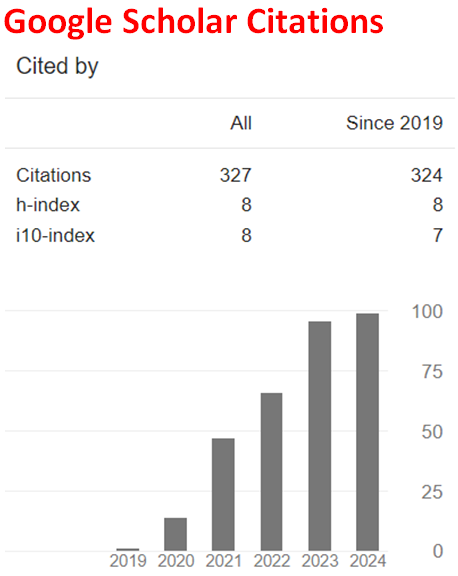Adsorption Capabilities of Activated Carbon Derived from Detarium microcarpum Seeds in Removing Co2+ and Pb2+ from Wastewater
Abstract
This study was carried out to evaluate the efficiency of metals (Pb and Co) removal from solution using Detarium microcarpum seeds as adsorbent. The effect of initial concentration and adsorbent dosage on the adsorption process of these metals were studied, the percentage removal of these metals increased with increased in weight (0.5 -2.5g) in 50ml of the solution and the adsorption efficiency increased with increasing initial metal ion concentration (0.01-0.05 moldm−3). The percentage removal obtained for Lead and Cobalt were compared. The result of adsorption were fitted to Langmuir models and coefficients indicated favorable adsorption of Pb2+ and Co2+ ions on the adsorbents. The adsorption of Pb2+ and Co2+ in aqueous solution was in the following order (1400µm>420µm>150µm). More than 55.4% of studied Lead cations were removed by 1400µm, 47.2% by 420µm and 29.8% by 150µm. While for Cobalt cations only 53.2% by 1400µm, 38.6% by 420µm and 24% by 150µm respectively, from aqueous solution it was concluded that, activated Carbon derived from Detarium microcarpum seed is good in removing both lead and cobalt ions, which make it good absorbent.
References
A. A. Mariod, M. E. S. Mirghani, A. B. Abdul and S. I. Abdelwahab, Detarium microcarpum Guill and Perr fruit proximate chemical analysis and sensory characteristics of concentrated juice and jam, Afr. J. Biotechnol. 8(17) (2009), 4217-4221.
Z. A. AL-Othman, R. Ali and Mu. Naushad, Hexavalent chromium removal from aqueous medium by activated carbon prepared from peanut shell: Adsorption kinetics, equilibrium and thermodynamic studies, Chemical Engineering Journal 184 (2012), 238-247. https://doi.org/10.1016/j.cej.2012.01.048
Z. Aksu and E. Kabasakal, Batch adsorption of 2,4-dichlorophenoxy-acetic acid (2,4-D) from aqueous solution by granular activated carbon, Separation and Purification Technology 35 (2004), 223-240. https://doi.org/10.1016/S1383-5866(03)00144-8
H. K. Alluri, S. R. Ronda, V. S. Settalluri, J. S. Bondili, V. Suryanarayana and P. Venkateshwar, Biosorption: An eco-friendly alternative for heavy metal removal, African Journal of Biotechnology 6(25) (2007), 2924-2931. https://doi.org/10.5897/AJB2007.000-2461
R. Ansari and A. Mohammad-khan, Activated charcoal: preparation, characterization and applications: A review article, International Journal of ChemTech Research 1(4) (2009), 859-864.
A. M. Kouyaté and P. van Damme, Medicinal plants/Plantes médicinales: Detarium microcarpum Guill. & Perr., Prota 11, no. 1 (2006). Accessed Novenber 24, 2012. http://database.prota.org/PROTAhtml/Detarium%20microcarpum_En.htm
B. Volesky, Detoxification of metal-bearing effluents: biosorption for the next century, Hydrometallurgy 59 (2001), 203-216. https://doi.org/10.1016/S0304-386X(00)00160-2
B. Innocent, D. Liaigre, D. Pascquier, F. Ropital, J.-M. Leger and K. B. Kokoh, Electro-reduction of carbon dioxide to formate on lead electrode in aqueous medium, Journal of Applied Electrochemistry 39(2) (2009), 227. https://doi.org/10.1007/s10800-008-9658-4
L. Carson, H. V. Ellis and J. L. McCann, Toxicology and Monitoring of Metals in Human, Lewis Publishers Inc., U.S.A., 1986, 130 pp.
H. Freundlich, Adsorption in solution, Z. Phys. Chem. (Germany) 57 (1906), 385-470.
J. G. Calvert, Glossary of atmosphere chemistry terms (Recommendation 1990), Pure and Applied Chemistry 62 (1990), 2167-2219. https://doi.org/10.1351/pac199062112167
“Glossary” The Brownfields and land Revitalization Technology Support Center, Retrieved 2009-12-21.
K. Kadirvelu, K. Thamaraiselvi and C. Namasivayam, Removal of heavy metal from industrial wastewater by adsorption onto activated carbon prepared from agricultural solid waste, Bioresource Technology 76 (2001), 63-65. https://doi.org/10.1016/S0960-8524(00)00072-9
P. S. Kumar and K. Kirthika, Equilibrium and kinetic study of adsorption of nickel from aqueous solution onto bael tree leaf powder, Journal of Engineering Science and Technology 4 (2009), 351-363.
A. R. Khan, H. Tahir, F. Uddin and U. Hameed, Adsorption of methylene blue from aqueous solution on the surface of wool fibre and cotton fibre, Journal of Applied Science and Environmental Management 9(2) (2005), 29-35. https://doi.org/10.4314/jasem.v9i2.17287
I. Langmuir, The adsorption of gases on plane surface of glass, mica and platinum, J. Am. Chem. Soc. 40(9) (1918), 1361-1403. https://doi.org/10.1021/ja02242a004
Lanntech Adsorption/activated carbon, www.lenntech.com/feedbach_uk. http://en.wikipedia.org/wiki/Adsorption retrieved on 4/30/2009
Y. Liu, Some consideration on the Langmuir isotherm equation, Colloids and Surface A: Physicochemical and Engineering Aspects 274 (2006), 34-36. https://doi.org/10.1016/j.colsurfa.2005.08.029
M. Mahejabeen, Removal of chromium ion from leather industrial waste by activated pure hulls, African J. Biotechnology 8(7) (2009), 1332-1336.
N. Oyaro, O. Juddy, E. N. M. Murago and E. Gitonga, The content of Pb, Cu, Zn and Cd in metal in meat in Nairobi Kenya, Journal of Novel Agriculture & Environment 5(3-4) (2007), 119-121.
Paulette Taita, Use of woody plants by locals in Mare aux Hippopotamus Biosphere Reverse in Western Burkina Faso, Biodiversity & Conservation 12(6) (2003), 1205-1217.
B. A. Shah, A. V. Shah and R. R Singh, Sorption isotherm and kinetic of chromium uptake from wastewater using natural sorbent material, Int. J. Environ. Sci. Technol. 6(1) (2009), 77-90. https://doi.org/10.1007/BF03326062
P. X. Sheng, Y. P. Ting, J. P. Chen and L. Hung, Sorption of lead, copper, cadmium, zinc and nickel by marine algal biomass: characteristic of biosorption capacity and investigation of mechanisms, Journal of Colloidal and Interface Science 275 (2004), 131-141. https://doi.org/10.1016/j.jcis.2004.01.036
N. K. Srivastava and C. B. Majumder, Novel biofiltration method for the treatment of heavy metals from industrial wastewater, Journal of Hazardous Material 151(1) (2008), 1-8. https://doi.org/10.1016/j.jhazmat.2007.09.101
M. T. Uddin, M. S. Islam and M. Z. Abedin, Adsorption of phenol from aqueous solution by water hyacinth ash, ARPN J. Engineering Applied Science 2(2) (2007), 11-17
W. S. Wan Ngah and M. A. K. M. Hanafiah, Removal of heavy metal ions from wastewater by chemical modified plants waste as adsorbents, A review, Bioresource Technology 99 (2008), 3935-3948. https://doi.org/10.1016/j.biortech.2007.06.011
B. Yu, Y. Zhang, A. Shukla, S. S. Shukla and K. L. Dorris, The removal of heavy metals from aqueous solution by sawdust adsorption - removal of lead and comparison of its adsorption with copper, Journal of Hazardous Material 84(1) (2000), 83-94. https://doi.org/10.1016/S0304-3894(01)00198-4

This work is licensed under a Creative Commons Attribution 4.0 International License.


